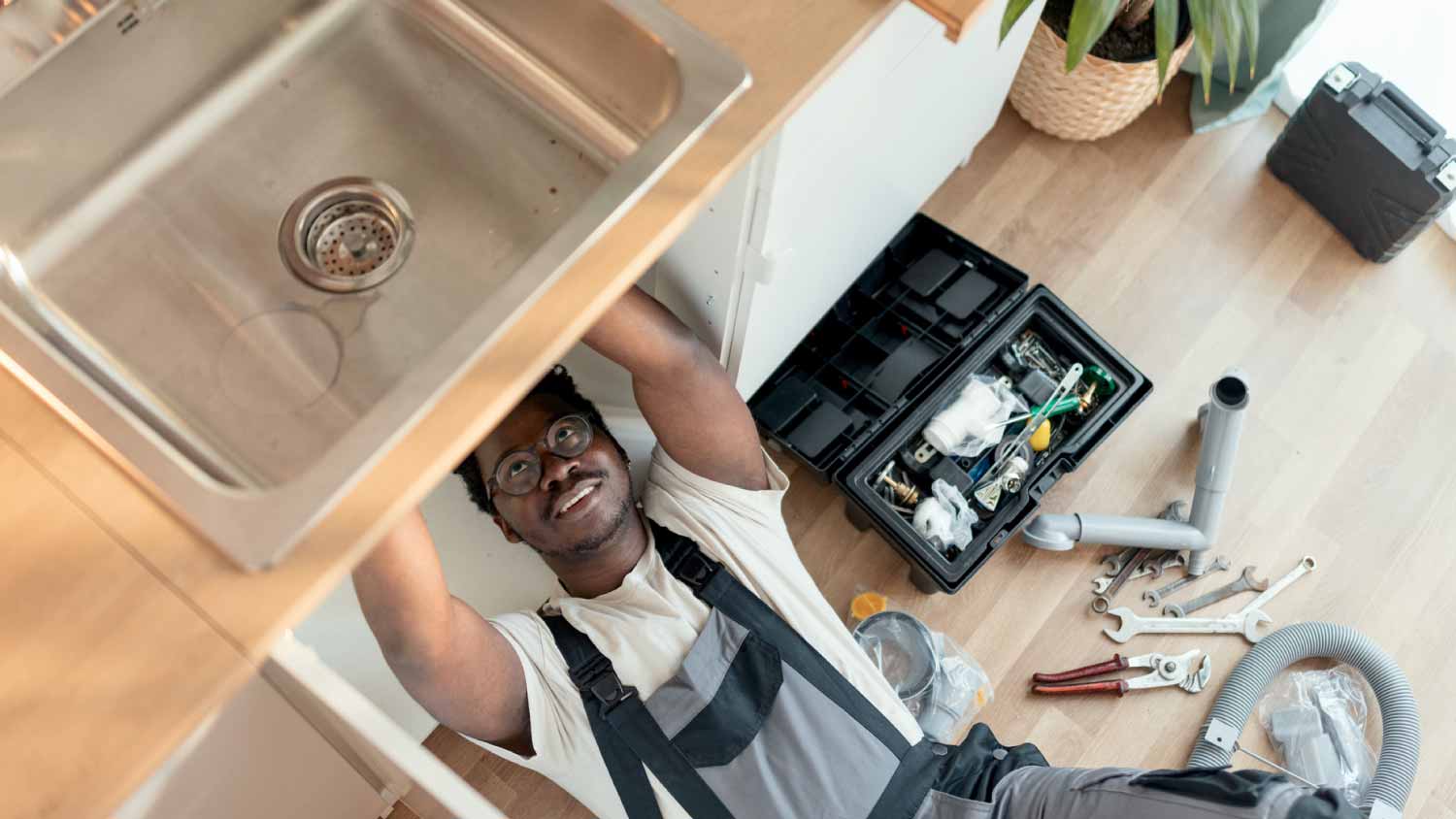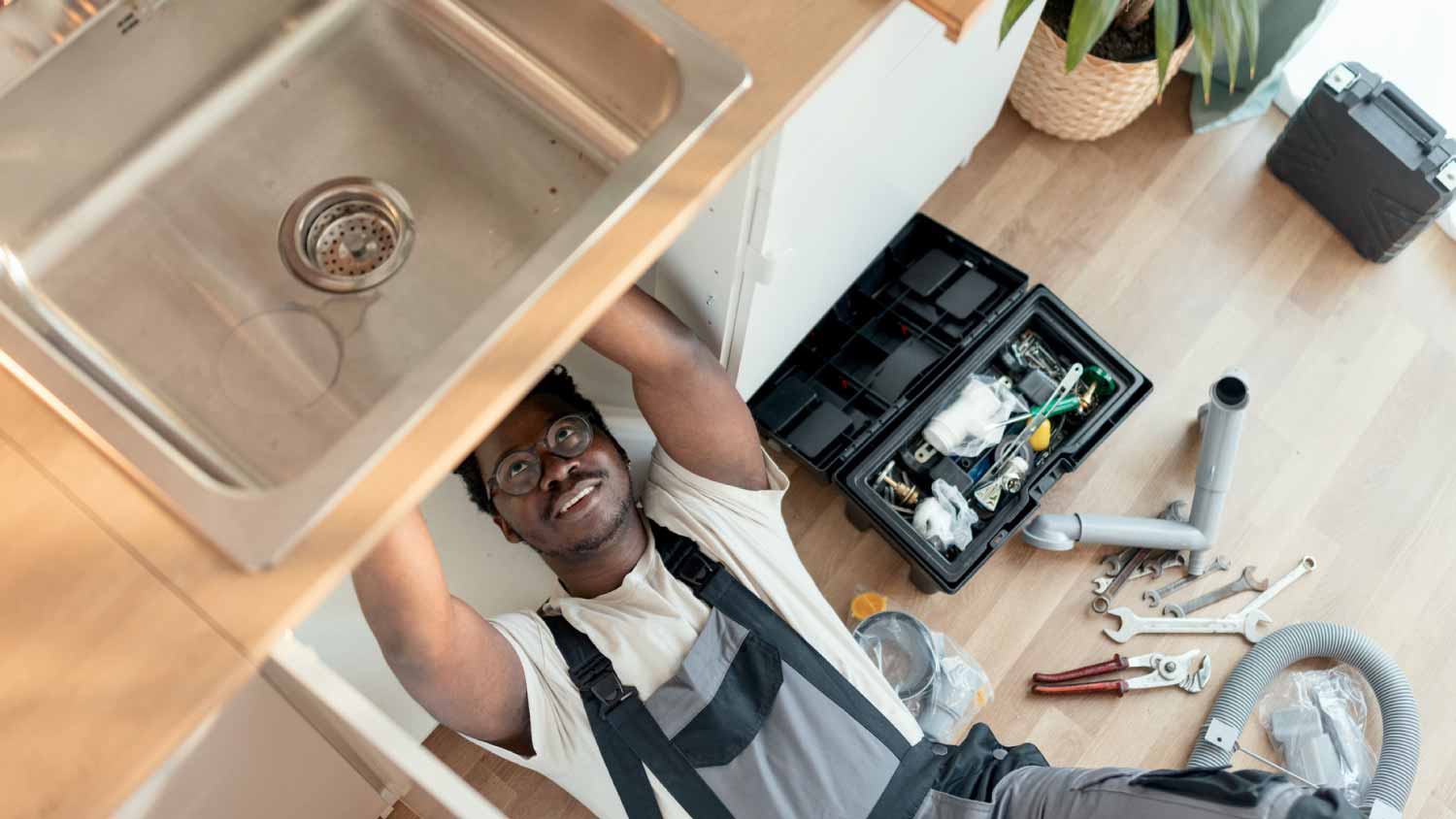Plumbing issues can turn your peaceful home into a stress zone in minutes. A sudden leak, a clogged drain, or a running toilet can cause costly water damage and unnecessary panic. While some problems require professional expertise, many common plumbing issues can be addressed with basic knowledge and a few simple tools. This guide will help you handle everyday plumbing challenges and recognize when it’s time to call in the experts.
Immediate Actions for Plumbing Emergencies (shutting off water supply, identifying the source of leaks, temporary fixes)

- A plumber working diligently under a sink, showcasing the importance of immediate actions during plumbing emergencies. Source: angi.com
When facing a plumbing emergency, your first action should always be locating and shutting off the appropriate water supply. For isolated issues like a leaking sink or toilet, turn off the water at the fixture’s shut-off valve, typically located beneath or behind the fixture. For major emergencies or if you can’t locate the specific shut-off, head to your home’s main water valve, usually found near your water meter, in the basement, crawl space, or outside near the foundation. Turning this valve clockwise will stop water flow to the entire house, preventing further damage while you address the problem.
Once the water is off, quickly identify the source of the leak. Remove standing water with towels or a wet vacuum to better inspect the affected area. For temporary fixes on leaking pipes, you can use pipe repair clamps, waterproof tape, or even a rubber patch secured with hose clamps until professional help arrives. For smaller leaks, applying plumber’s epoxy putty can serve as a short-term solution. Remember to take photos of the damage for insurance purposes before implementing any fixes, and keep the area dry to prevent mold growth and further structural damage while awaiting permanent repairs.

- A plumber skillfully using a drain snake to resolve common drain clogs in sinks, toilets, and showers. Source: angi.com
Tackling Common Drain Problems (clearing clogs in sinks, toilets, and showers using DIY methods and tools)
Clogged drains rank among the most frustrating yet common household plumbing problems. For sink clogs, start with the simplest solution: boiling water. Pour it directly down the drain to dissolve grease and soap scum. If that doesn’t work, try a mixture of baking soda and vinegar—pour half a cup of baking soda followed by half a cup of vinegar, cover the drain for 30 minutes, then flush with hot water. For more stubborn clogs, a plunger designed for sinks (different from toilet plungers) or a drain snake can physically dislodge the blockage without damaging your pipes or introducing harsh chemicals.

- An overview of common plumbing problems, including leaky fixtures and pipes, as discussed in the section. Source: angi.com
For toilet clogs, always begin with a proper flange plunger, ensuring you create a good seal before applying several firm, consistent plunges. If the clog persists, a toilet auger (also called a closet auger) can reach deeper obstructions without scratching the porcelain. For shower drains, hair is typically the culprit—try removing the drain cover and extracting visible hair with a bent wire hanger or specialized hair-removal tool. Regular maintenance using enzyme-based drain cleaners can prevent future buildup. Remember that commercial drain chemicals should be a last resort as they can damage pipes and create toxic fumes when mixed with other cleaning products.
Fixing Leaky Fixtures and Pipes (addressing faucet drips, pipe leaks, and toilet runs)

- Professional handyman services are essential for regular inspections and preventative maintenance in plumbing. Source: anythingpossiblehandyman.com
A dripping faucet wastes gallons of water and creates that maddening sound that keeps you up at night. Most faucet leaks result from worn-out washers, O-rings, or cartridges—components that are relatively inexpensive and straightforward to replace. Start by shutting off the water supply to the fixture, then disassemble the faucet carefully, taking photos of each step to ensure proper reassembly. Inspect rubber washers and O-rings for wear and replace them as needed. For cartridge faucets, the entire cartridge might need replacement. Hardware stores typically stock replacement parts for common faucet brands, and many manufacturers offer repair kits.
Running toilets can waste hundreds of gallons of water daily. The most common cause is a faulty flapper valve that no longer creates a proper seal, allowing water to continuously flow from the tank into the bowl. Replacing the flapper is an easy fix requiring no special tools. Other potential issues include a misadjusted or broken fill valve or an improperly positioned float. Toilet repair kits containing all these components are available for under $20 and include instructions. For pipe leaks, compression fittings or pipe repair clamps can provide permanent solutions for minor issues. Copper or PVC pipe sections might require cutting out the damaged portion and replacing it with new pipe using appropriate couplings—a more advanced DIY project that requires basic plumbing tools.
Preventative Maintenance Tips (regular inspections, proper usage habits, when to call a professional plumber)
Proactive maintenance is your best defense against plumbing emergencies. Establish a routine inspection schedule for your home’s plumbing system—check under sinks for moisture or water stains, examine exposed pipes for corrosion or small leaks, and listen for unusual sounds like running water when fixtures aren’t in use. Test your water pressure annually using an inexpensive gauge; consistently high pressure (above 80 psi) can strain pipes and cause premature failure of appliance valves and fittings. In cold climates, insulate pipes in unheated areas before winter to prevent freezing and potential bursts. Educate everyone in your household about what should never go down drains: grease, coffee grounds, and fibrous foods in kitchen sinks; “flushable” wipes, feminine products, and excessive paper in toilets.
While DIY solutions work for many common issues, certain situations warrant professional attention. Call a licensed plumber immediately for sewer line backups, multiple drains clogging simultaneously, water heater failures, or any leak you can’t quickly identify and control. Persistent low water pressure throughout the house, discolored water, or unusual odors may indicate serious issues with your water supply or sewer system. For older homes, consider a professional plumbing inspection every 3-5 years to identify potential problems before they become emergencies. Remember that attempting complex repairs without proper knowledge can transform a simple issue into a costly disaster—when in doubt, investing in professional service can save money and stress in the long run.
